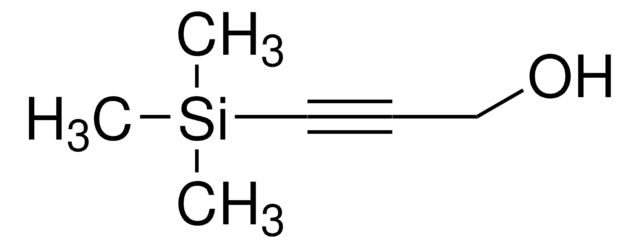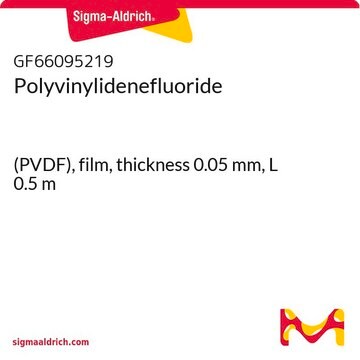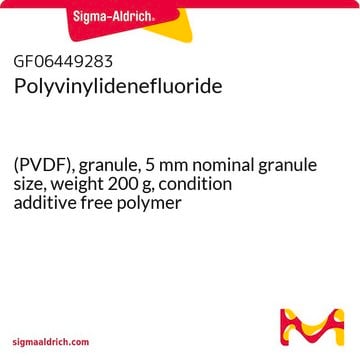347078
Poly(vinylidene fluoride)
average Mw ~530,000, pellets
Synonym(s):
PVDF
Sign Into View Organizational & Contract Pricing
All Photos(2)
About This Item
Linear Formula:
(CH2CF2)n
CAS Number:
MDL number:
UNSPSC Code:
12162002
PubChem Substance ID:
NACRES:
NA.23
Recommended Products
vapor pressure
15 mmHg ( 32 °C)
form
pellets
mol wt
average Mw ~530,000
SMILES string
FC(F)=C
InChI
1S/C2H2F2/c1-2(3)4/h1H2
InChI key
BQCIDUSAKPWEOX-UHFFFAOYSA-N
Looking for similar products? Visit Product Comparison Guide
Related Categories
Application
- A critical analysis of the α, β and γ phases in poly (vinylidene fluoride) using FTIR: This study provides detailed insights into the different crystalline phases of PVDF, which are crucial for applications in sensors and actuators (Cai et al., 2017).
- Properties and applications of the β phase poly (vinylidene fluoride): This research explores the unique properties of the β phase of PVDF, widely used for its piezoelectric and ferroelectric properties, relevant in various technological applications (Ruan et al., 2018).
- Ultrahigh β-phase content poly (vinylidene fluoride) with relaxor-like ferroelectricity for high energy density capacitors: This article discusses the potential of high β-phase PVDF in energy storage applications, which could interest material scientists focusing on energy solutions (Meng et al., 2019).
- Multiscale-structuring of polyvinylidene fluoride for energy harvesting: This study investigates how different scales of structural modification affect the energy harvesting capabilities of PVDF, important for both material science and sustainable energy research (Wan & Bowen, 2017).
- Recent advances in poly (vinylidene fluoride) and its copolymers for lithium-ion battery separators: This review highlights the applications of PVDF in the development of lithium-ion battery separators, essential for advancing energy storage technologies (Barbosa et al., 2018).
Storage Class Code
11 - Combustible Solids
WGK
WGK 3
Flash Point(F)
Not applicable
Flash Point(C)
Not applicable
Personal Protective Equipment
dust mask type N95 (US), Eyeshields, Gloves
Choose from one of the most recent versions:
Certificates of Analysis (COA)
Lot/Batch Number
Don't see the Right Version?
If you require a particular version, you can look up a specific certificate by the Lot or Batch number.
Already Own This Product?
Find documentation for the products that you have recently purchased in the Document Library.
Customers Also Viewed
Christian M Coviello et al.
IEEE transactions on ultrasonics, ferroelectrics, and frequency control, 59(10), 2322-2330 (2012-11-13)
A new 2-D hydrophone array for ultrasound therapy monitoring is presented, along with a novel algorithm for passive acoustic mapping using a sparse weighted aperture. The array is constructed using existing polyvinylidene fluoride (PVDF) ultrasound sensor technology, and is utilized
Weijie Dong et al.
Analytical chemistry, 84(20), 8461-8466 (2012-09-07)
The isolation and characterization of mucins are critically important for obtaining insight into the molecular pathology of various diseases, including cancers and cystic fibrosis. Recently, we developed a novel membrane electrophoretic method, supported molecular matrix electrophoresis (SMME), which separates mucins
I S ivanov et al.
Tsitologiia, 54(10), 783-789 (2013-01-05)
Nowadays, the use of synthetic prosthesis is obligatory method in surgical treatment of large and giant ventral hernias. We have fulfilled comparative investigation of the dynamics of collagen Type I to Type III ratio in paraprosthetic region in mice when
S V Ivanov et al.
Klinichna khirurhiia, (7)(7), 37-41 (2012-10-05)
The results of experimental and clinical studies for the comparative evaluation of implants used in herniology of polytetrafluoroethylene (PTFE) and polyvinylidene fluoride (PVDF) are presented. Experimental investigations conducted on 200 mice, which in the anterior abdominal wall mesh prosthesis implanted.
Archana Kayyar et al.
Journal of visualized experiments : JoVE, (66)(66), e4104-e4104 (2012-08-17)
Rechargeable lithium ion batteries have wide applications in electronics, where customers always demand more capacity and longer lifetime. Lithium ion batteries have also been considered to be used in electric and hybrid vehicles or even electrical grid stabilization systems. All
Our team of scientists has experience in all areas of research including Life Science, Material Science, Chemical Synthesis, Chromatography, Analytical and many others.
Contact Technical Service






